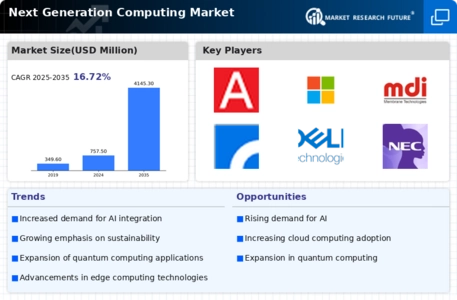Next Generation Computing Size
Next Generation Computing Market Growth Projections and Opportunities
The market dynamics of the next generation computing market are shaped by a myriad of factors, ranging from technological advancements to consumer demands and competitive landscapes. At its core, next-generation computing encompasses a wide array of emerging technologies, including quantum computing, artificial intelligence (AI), edge computing, and blockchain. Each of these segments brings its own set of opportunities and challenges, driving the overall market dynamics.
Quantum computing stands at the forefront of next-generation computing, promising unprecedented computational power that can revolutionize industries ranging from finance to healthcare. As research and development efforts intensify, the market for quantum computing is witnessing significant growth, albeit still in its nascent stages. Companies are racing to develop quantum processors, algorithms, and software platforms, fueling competition and innovation within the sector.
Artificial intelligence, another key driver of next-generation computing, is permeating various industries, enabling advanced data analysis, automation, and decision-making capabilities. The AI market is characterized by fierce competition among tech giants and startups alike, vying for market share and technological leadership. As AI algorithms become more sophisticated and accessible, businesses are increasingly integrating AI-powered solutions into their operations to gain a competitive edge.
Edge computing, a paradigm that involves processing data closer to its source rather than relying solely on centralized data centers, is gaining traction in response to the growing demands for real-time processing and low-latency applications. With the proliferation of Internet of Things (IoT) devices and the need for efficient data processing at the network edge, the edge computing market is poised for significant expansion. Companies are investing in edge computing infrastructure and solutions to capitalize on this emerging trend.
Blockchain technology, initially popularized by cryptocurrencies, has evolved to offer secure and decentralized solutions for various applications beyond finance, including supply chain management, healthcare, and digital identity verification. The blockchain market is characterized by a diverse ecosystem of startups, enterprises, and consortia, each exploring innovative use cases and interoperability solutions. As blockchain matures and regulatory frameworks evolve, the market dynamics are shaped by factors such as scalability, security, and regulatory compliance.
Amidst these technological advancements, the next-generation computing market is also influenced by broader macroeconomic trends, geopolitical factors, and regulatory environments. Global economic uncertainties, trade tensions, and geopolitical risks can impact investment decisions and market sentiment, affecting the pace of innovation and adoption within the industry. Additionally, regulatory developments related to data privacy, cybersecurity, and intellectual property rights play a crucial role in shaping market dynamics and influencing business strategies.
Moreover, consumer preferences and societal trends contribute to the evolution of the next-generation computing market. As individuals and businesses increasingly rely on digital technologies for communication, commerce, and entertainment, there is a growing demand for more powerful, efficient, and secure computing solutions. Companies that can anticipate and address these evolving needs stand to gain a competitive advantage in the market.











Leave a Comment